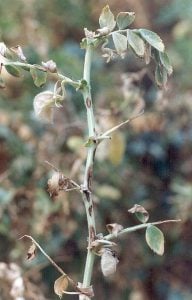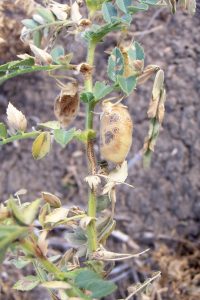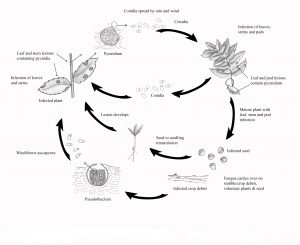Note: Current varieties have limited resistance to ascochyta blight
Ascochyta blight of chickpea is caused by the fungal pathogen Phoma rabiei (formerly known as Ascochyta rabiei) which is specific to chickpea. This is considered to be the most important fungal disease of chickpea worldwide. In 1998 a serious outbreak of the disease occurred in Victoria, South Australia and New South Wales which destroyed many crops. As a consequence the area sown to chickpea fell significantly, due to the high susceptibility of chickpea varieties to ascochyta blight. Since that time, chickpea varieties have had improved foliar resistance to ascochyta blight. However, recent changes in the pathotype present in Victoria has reduced the resistance available in commercial varieties. Breeding lines currently under evaluation are showing a more resistant reaction to ascochyta however until more resistance is available to growers, fungicides will play an important role in ascochyta management.
What to Look For
This disease becomes obvious in late winter when small patches of blighted plants first appear throughout the paddock. The disease spreads during rainfall events in spring from infected plants to surrounding plants by rain splash of spores. This forms large blighted patches within crops.
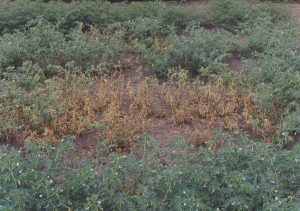
Ascochyta blight patches occur within a crop as the disease spreads from infected plants to surrounding healthy plants through rainsplash.
Ascochyta blight patches occur within a crop as the disease spreads from infected plants to surrounding healthy plants through rainsplash.Initially ascochyta blight appears on the younger leaves as small water-soaked pale spots. These spots rapidly enlarge, under cool and wet conditions, joining with other spots on the leaves and blighting the leaves and buds. Small black bodies (pycnidia) can be seen in the affected areas. In severe cases the entire plant dries up quickly. Elongated lesions form on the stem and may girdle the stem which may then die and break off. Regrowth may occur from this point. Affected areas on the pods tend to be round, sunken, with pale centres and dark margins. The fungus can penetrate the pod and infect the seed.
When infected seeds are sown, the emerging seedlings will develop dark brown lesions at the base of the stem. Affected seedlings may collapse and die.
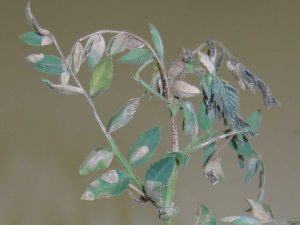
Typical leaf lesions caused by Ascochyta blight. These are seen as round spots with brown margins. Small dark specks (pycnidia) are often present.
Disease Cycle
This fungal disease has an asexual (non-sexual) and sexual stage; the asexual stage occurs in Australia, whilst the sexual stage has not been found in Australia. The fungus survives on infected seed and on old chickpea trash. Sowing infected seed will give rise to infected seedlings that initiate infection within crops. The pathogen can also be carried into new season crops on wind-blown chickpea trash, which can spread the pathogen when it comes into contact with seedlings. Infection can occur at any stage of plant growth provided conditions are favourable. Moisture is essential for infection to occur. During wet weather, the disease can spread further as spores of the fungus are carried onto neighbouring plants by wind and rain splash.
Management
Management of ascochyta blight requires a combination of farm hygiene, variety resistance, crop monitoring and the use of fungicides. When growing a new variety, obtain a copy of the variety management package for information on specific disease management.
Please note, the ascochyta blight pathogen population has evolved in recent years. This has resulted in changes in pathogenicity and has decreased the level of resistance in current chickpea varieties. Please check current sowing guides for the latest disease resistance ratings in your region, which have reduced for most varieties.
A resistant variety will only need a fungicide at podding to protect seed quality.
For chickpea varieties (rated susceptible to moderately resistant) the following management strategies should be applied:
- Use seed from a paddock where ascochyta was not detected or was well managed.
- Treat all seed with a fungicide seed dressing registered for ascochyta blight control.
- Choose a paddock at least 500 metres from last years chickpea crop.
Varieties rated MS will need three to four strategic fungicide applications during the season (starting six to eight weeks after sowing). Susceptible varieties will need regular fungicide applications every two to three weeks throughout the growing season. Fungicides should be applied before rain fronts. All varieties are susceptible to pod infection and will require protection during podding to prevent seed staining and abortion.
Note: sprays only protect the plant parts which come in contact with the spray, subsequent plant growth will not be protected.
- A fungicide spray at pod set is essential to ensure production of premium quality seed.
- Always disinfect machinery, vehicles and boots once they have been in an infected crop.
Breeding programs in Australia are developing chickpea varieties with improved ascochyta blight resistance. All current varieties and future releases will still require spraying at podding time, as their pods are susceptible to infection. However, the greatly reduced number of spray applications required for resistant varieties make chickpea a profitable crop to grow.
If resistant varieties are grown over larger areas, ascochyta is controlled well, or it is a low disease year, there is likely to be a reduction in the amount of ascochyta blight inoculum present. This should reduce the risk of further serious disease outbreaks.

